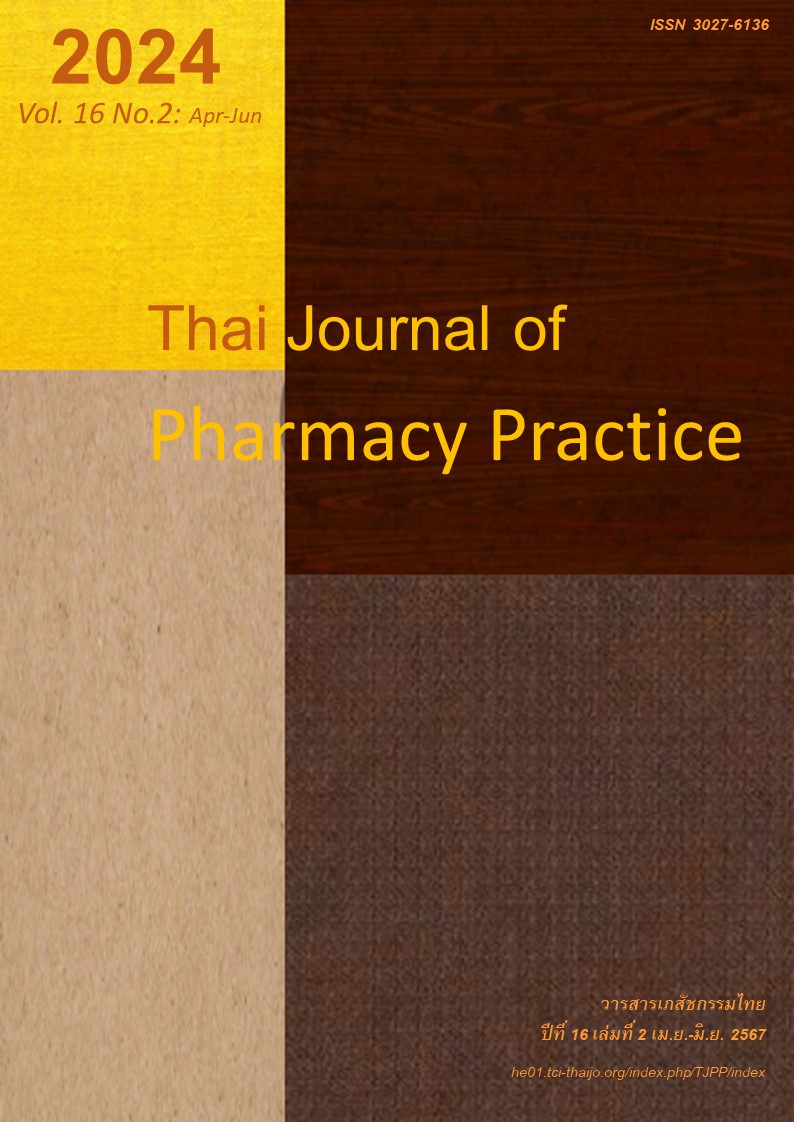การพัฒนาสื่อวิธีใช้ยาสูดพ่นสำหรับโรคหอบหืดและ โรคปอดอุดกั้นเรื้อรังด้วยเทคโนโลยีความเป็นจริงเสริม
Main Article Content
บทคัดย่อ
วัตถุประสงค์: เพื่อพัฒนาสื่อให้ความรู้เรื่องยาสำหรับผู้ป่วยโรคหอบหืดและโรคปอดอุดกั้นเรื้อรังด้วยเทคโนโลยีความเป็นจริงเสริม ประเมินประสิทธิภาพและประสิทธิผลของสื่อ และความพึงพอใจของผู้ใช้งาน วิธีการ: ผู้วิจัยพัฒนาสื่อเทคโนโลยีความเป็นจริงเสริมด้วย ADDIE Model ด้วยโปรแกรม Unity3D และ Vuforia Engine สื่อประกอบด้วยความรู้เรื่องยาสูดพ่นชนิด MDI 8 หัวข้อ ผู้ใช้สามารถสแกนกล่องยาสูดพ่นชนิด MDI ผ่านกล้องของสมาร์ทโฟนเพื่อเข้าถึงสื่อให้ความรู้ สื่อได้รับการประเมินประสิทธิภาพโดยผู้เชี่ยวชาญด้านเทคโนโลยีสารสนเทศ 4 คน การประเมินประสิทธิผลของสื่อทำโดยผู้วิจัยประเมินความถูกต้องของขั้นตอนการใช้ยาและความรู้เรื่องยาสูดพ่นชนิด MDI ของผู้เข้าร่วมโครงการวิจัย 2 กลุ่มที่แบ่งกลุ่มด้วยการสุ่มแยกกลุ่ม เป็นกลุ่มที่ได้รับคำแนะนำเรื่องการใช้ยาสูดพ่นชนิด MDI ผ่านสื่อ และกลุ่มที่ได้รับคำแนะนำจากเภสัชกร การประเมินทำทันทีหลังการดูสื่อหรือได้รับคำแนะนำ ผู้เข้าร่วมโครงการวิจัยกลุ่มที่ได้ดูสื่อเป็นผู้ประเมินความพึงพอใจต่อสื่อ ผลการวิจัย: สื่อเทคโนโลยีความเป็นจริงเสริมที่พัฒนาขึ้นมีประสิทธิภาพโดยรวมคิดเป็นร้อยละ 85 ส่วนในด้านประสิทธิผล กลุ่มที่ใช้สื่อมีคะแนนเฉลี่ยความเข้าใจวิธีและขั้นตอนการพ่นยาสูดพ่นชนิด MDI 11.33±1.44 จากคะแนนเต็ม 13 คะแนน ซึ่งไม่แตกต่างจากกลุ่มที่ได้รับคำแนะนำจากเภสัชกร (11.60±0.67) กลุ่มที่ใช้สื่อมีค่าเฉลี่ยความรู้เกี่ยวกับยาสูดพ่นชนิด MDI 8.87±1.07 จากคะแนนเต็ม 10 คะแนน ซึ่งมีคะแนนเฉลี่ยสูงกว่ากลุ่มที่ได้รับคำแนะนำจากเภสัชกร (8.30±1.06) อย่างมีนัยสำคัญทางสถิติ (P<0.05) ผู้ใช้งานมีความพึงพอใจต่อสื่อเฉลี่ยอยู่ในระดับมาก (4.50±0.12 จากคะแนนเต็ม 5 คะแนน) โดยมีความพึงพอใจสูงสุดด้านความรู้เรื่องการใช้ยาสูดพ่น (4.67±0.61) สรุป: สื่อเทคโนโลยีความเป็นจริงเสริมสำหรับให้ความรู้เรื่องยาสูดพ่นชนิด MDI ที่พัฒนาขึ้น สามารถใช้เป็นสื่อให้ความรู้แก่ผู้ป่วยโรคหอบหืดและปอดอุดกั้นเรื้อรังได้อย่างมีประสิทธิภาพและมีประสิทธิผล ผู้ป่วยมีความพึงพอใจในการใช้งาน ผลการศึกษานี้สามารถนำไปประยุกต์ในการสร้างสื่อให้ความรู้เรื่องยาและสุขภาพอื่นต่อไป
Article Details

อนุญาตภายใต้เงื่อนไข Creative Commons Attribution-NonCommercial-NoDerivatives 4.0 International License.
ผลการวิจัยและความคิดเห็นที่ปรากฏในบทความถือเป็นความคิดเห็นและอยู่ในความรับผิดชอบของผู้นิพนธ์ มิใช่ความเห็นหรือความรับผิดชอบของกองบรรณาธิการ หรือคณะเภสัชศาสตร์ มหาวิทยาลัยสงขลานครินทร์ ทั้งนี้ไม่รวมความผิดพลาดอันเกิดจากการพิมพ์ บทความที่ได้รับการเผยแพร่โดยวารสารเภสัชกรรมไทยถือเป็นสิทธิ์ของวารสารฯ
เอกสารอ้างอิง
Thai Asthma Council. Guideline for adult asthma management in Thailand 2019. Bangkok: Beyond Enterprise; 2018.
Poachanukoon O. Uncovering asthma misconception [online]. 2021 [cited Oct 30, 2022]. Available from: www.tac.or.th/wp-content/uploads/2021/05/Final_Press-Release-World-Asthma-Day-2021.pdf.
Somjan P. Effect of drug counseling in the patient with chronic obstructive pulmonary disease in Phu Khieo Chalem Prakiat Hospital, Chaiyaphum Province. Chaiyaphum Medical Journal 2022; 41: 49-57.
Thoracic Society of Thailand under Royal Patronage. Thai COPD guideline 2017. Bangkok: beyond enterprise; 2017.
Wanichwatphibun D. Problems with Inhalation technique. Thai Journal of Tuberculosis, Chest Diseases and Critical Care 2017; 37: 52-5.
Pansa S, Srichada P, Siwaborwornwattana A, Tedrapeemetawenumchai S. Improved clinical outcomes in asthmatic and copd inhaler users with multimedia-acquired pharmacy counseling. Journal of Health Science 2016; 25: 436-45.
Sukhokanjanachusak K. The coronavirus 2019 (Covid-19) pandemic on treatment outcome and requirement of the cancer patient in Suratthani hospital. Region 11 Medical Journal 2021; 35: 124-36.
Department of Medical Sciences. Medical innovation [online]. 2019 [cited Oct 30, 2022]. Available from: bit.ly/3SUieRY.
Rathachatranon W. Determining an appropriate sample size for social science research: The Myth of using Taro Yamane and Krejcie & Morgan method. Journal of Interdisciplinary Research 2019; 8: 11-28.
Srisa-ard B. Introduction to research. 10th ed. Bangkok: Suweeriyasarn; 2017.
Google developer. About Android App Bundles [online]. 2022 [cited Jan 15, 2023]. Available from: developer.android.com/guide/app-bundle.
Ahmadvand A, Drennan J, Burgess J, Clark M, Kavanagh D, Burns K, et al. Novel augmented reality solution for improving health literacy around antihypertensives in people living with type 2 diabetes mellitus: Protocol of a technology evaluation study. BMJ Open. 2018; 8: e019422. doi: 10.1136/bmjopen-2017-019422.
Department of Pharmacy at Phramongkutklao Hospital. Drug delivery devices and administration technique. Bangkok: Pauramutha Printing; 2014
Reynolds J. Promoting self – care through the use of augmented reality: Case study of diabetic patients, diabetic clinic [dissertation]. Bangkok: University of Siam; 2020.
Ngamwannakorn C. Development of a learning application on mobile device in English for information officer [dissertation]. Yala: Yala Rajabhat University; 2019.
Education168. Building augmented reality applica- tion with unity [online]. 2023 [cited Feb 13, 2023]. Available from: shorturl.asia/jhvQ5.


